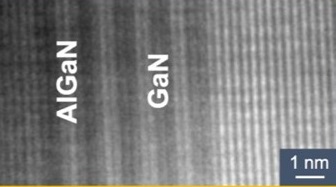New ultraviolet (UV) light-emitting diodes (LEDs) have been commercially available for only a few years and are actually used for various applications such as fluorescence, polymerization, catalysis, skin disease treatment and UV disinfection. Researchers at IRIG have recently succeeded in miniaturizing this type of LED at micrometer scale to fabricate UV microLEDs, based on nanowire with a diameter 100 times smaller than a hair.
Researchers at IRIG, in collaboration with the Neel Institute, have developed an alternative approach using nanowires to fabricate UV microLEDs. This “nanowire” dramatically reduces the effect of dislocations within the material, increases the UV emissive surface area and improves UV light extraction. This micro-LED emits in UV-B range at 310 nm. Based on GaN nanowires, the UV-LED structure is epitaxially grown in a core/shell geometry, integrating a UV source inserted into an AlGaN diode (p-n junction). Two types of active structures emitting in the UV-B range have been successfully developed: 1) GaN quantum wells with a thickness of only 0.7 nm, corresponding to 3-4 atomic monolayers of GaN, or (2) a GaN/AlGaN superlattice to modulate the crystal composition at the scale of only 2 monolayers called a digital alloy (cf.
Figure).
 Figure
Figure: TEM Image of the UV active zone consisting on a GaN/AlGaN superlattice where each layer is 2 atomic monolayers thick.
In the semiconductor field, these pioneering works on the development of miniaturized UV-LEDs with core-shell nanowire represent a significant advancement in the field of UV light sources and nanophotonics. Today, researchers of IRIG target to design UV-C LED based on nanowires and hope to make flexible UV LEDs on large surface from an assembly of these nanowires. The very first results on flexible UV-LED look particularly promising and will soon be presented at the 14th ICNS conference 2023 in Japan.
This new device paves the way for new applications, such as UV pixel displays for biological detection and on-demand photolithography, or the fabrication of flexible UV-LEDs.
Fundings: Program Initiatives de Recherche Stratégiques (IRS) of IDEX Université Grenoble Alpes (ANR-15-IDEX-0002) and the ANR project HARALN (ANR-22-CE51-0032-01).